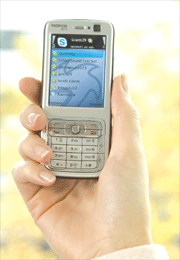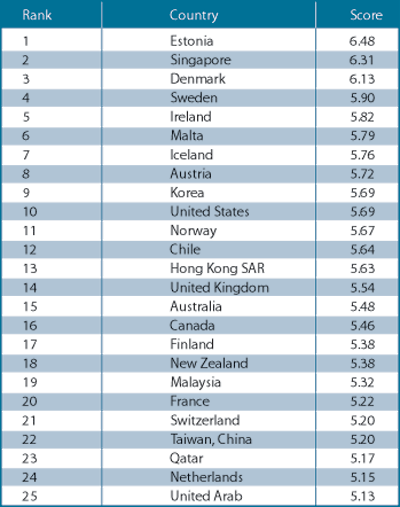

The incredible growth in mobile phones has started a new debate and reflection: Why can’t we use the ubiquitous mobile phone device as a delivery platform for all sorts of governmental or public information services and hence help foster much needed interaction between government and citizens? With 3.3 billion mobile users around today, and a growing users base, the prospects and possibilities in using the mobile phones as a two-way service delivery platform are incredible. Mobile phones are more ubiquitous in developing countries than the older media of choice for one way communications : TV sets, or radio. However, just like TV and radio, mobile phones can carry various sources of content, coming from both the private or the public sphere.

Mobile phones also can help foster an innovative method for citizens to interact with the government. Government can provide needed and sometimes life-saving information to citizens via phone or Short Messaging Service (SMS) based alerts. In order to get there, a cultural and organisational change is needed: Governments need to change their attitude towards provision of services and transform their models of providing public information to citizens. Governments need to create a culture of written and oral accountability and follow-through in order to achieve and maintain such a transformation. With information services available on devices that can record caller identity, gone is the faceless bureaucracy.
In this brave new world of information on the go, the public sector would make available contact names, appointment times, and employees’ calendars and make their public servants accountable in providing on-time professional and reliable services, transactions or plain reliable information provision. Information provided to citizens would need to be accurate, acceptable across the board and most of all irrefutable by the different parts of government that would be processing the related transaction (registration, payment, renewal, etc). Citizens interested, or concerned in a specific service can and should be able to directly contact the government, by SMS, or voice, and get their questions answered within a specific time frame (varying on the urgency of the request). This changes the paradigm of the amorphous bureaucracy by appointing clear contact points and jurisdictions for specific services and information provided by the government. The benefits are clear; half the planet with 3.3 billion users of mobile telephony could lead safer and better lives with factual information services at their fingertips helping them make educated choices and better decisions, from what crops to plant, to what roads not to take during a natural disaster, to how to prevent specific diseases, to whom to go to in your district to protect yourself in cases of domestic violence.

For many committed administrations in developing countries, a mobile services-based strategy is an innovative way to showcase to its citizens and elected bodies how responsive and serious they are about good governance, and empowering citizens. For many others the change of mindset, the level of efforts needed, and the leadership required is simply not there to help achieve the transformation from an information-poor to an information-rich environment. For some governments who perhaps have the financial and organisational skills to operate such a change, the political will is missing, and there is no burning desire to serve, assist, or empower the citizens. These governments are not yet seeing the possibilities that mobile phones offer them to get closer to their citizens by providing a two-way communication, information exchange and feedback process; or are in fact unconcerned or wary of this potential.
On the positive side, we are seeing a lot of changes from some governments who are serious about improving the livelihood’s of their citizens as these are making a concerted effort to talk to citizens and operators and see what can be offered in a specific platform. The latest e-Readiness ranking we have seen from INSEAD and the World Economic Forum Executive Opinion Survey in the latest annual Networked Readiness Index report (http://www.insead.edu/v1/gitr/wef/main/home.cfm) ranks Estonia, Singapore, Canada, Australia, USA etc. amongst top 10 performers in e-Readiness and availability of services to their communities, businesses and citizens. These are the same top 25 countries in provision of mobile government services to citizens. The new entrants include Dubai and Qatar, who have been achieving remarkable progress in the e-Government space.
 The index looks at the availability of government services online (personal tax, car registrations, business permits, passport applications, e-Procurement applications etc.). These services are based on the traditional web-based delivery platform for e-Government services, but several of them are now being migrated to the mobile platform under different agreements between the government and the mobile operators.
The index looks at the availability of government services online (personal tax, car registrations, business permits, passport applications, e-Procurement applications etc.). These services are based on the traditional web-based delivery platform for e-Government services, but several of them are now being migrated to the mobile platform under different agreements between the government and the mobile operators.
Examples of such services offered by government in partnership with cellular providers are (1) one-stop access to government services via mobile citizen service centres in Sao Paulo and Bahia, Brazil; (2) security alerts sent out by London’s Metropolitan police; (3) disaster recovery relief for British tourists in Sri Lanka being located and saved after Tsunami; (4) Singaporeans receiving SMS alerts for passport renewal notifications, and season parking reminders; (5) the Hong Kong government using SMS for emergency announcements; (6) in China, the mobile phone owners able to send SMS to the 2,987 deputies of the National People’s Congress; (7) in Fairfax county, VA SMS based weather and traffic updates sent to subscribers (8) in Estonia paying or parking (9) in Ireland, 48 per cent of mobile phone users use their mobile phones to get reminders for appointments with public health agencies.
At the moment, most of the initiatives are fairly small-scale and to varying extents experimental, but experts in the field suggest that the rate of innovation means that the system will soon be in routine use almost everywhere.
 Mobile services in Tartu, Estonia: Tartu, with its population of 100,000 inhabitants, is one of the leading cities in Estonia to introduce municipal m-Government services, from m-Banking, to m-Positioning to m-Education, m-Library, m-Hospital. Citizens can send SMS to the government officials on issues related to security, law and order, utilities, weather conditions and disaster management. They can make appointments with government officials by SMS and get notified or reminded of exact time of dental or medical appointment. Singapore is also a leader in the mobile government based services.
Mobile services in Tartu, Estonia: Tartu, with its population of 100,000 inhabitants, is one of the leading cities in Estonia to introduce municipal m-Government services, from m-Banking, to m-Positioning to m-Education, m-Library, m-Hospital. Citizens can send SMS to the government officials on issues related to security, law and order, utilities, weather conditions and disaster management. They can make appointments with government officials by SMS and get notified or reminded of exact time of dental or medical appointment. Singapore is also a leader in the mobile government based services.
(http://www.ecitizen.gov.sg/mobile/index.html). Singapore’s mobile penetration rate has reached a high of 9 per cent. Today, the mobile phone can be used to pay fines, vehicle registration, and driver license, get traffic and weather information as well as vote via SMS on various issues, surveys, elections, etc.
In South Africa SMS messaging is used to report domestic violence incidents against women and children in rural areas. The operator, Clickatell, donates free SMS credits so that relevant information on human rights is propagated to its subscribers, and allows as well access to agricultural extension information. The project is managed by Fahamu, an African organisation whose newsletter was voted in 2005 and 2006 as one of the top 10 websites changing the world of politics.
There are many innovations governments could lead in partnership with mobile operators to transform its delivery of services. Government payroll management is usually costly and very difficult to maintain, and often the object of controversy, corruption or inaccurate record management (duplication of records, erroneous payroll figures, erroneous entities listed) could for instance be outsourced to the mobile operators content developers, and could become a much more improved ‘m-Banking’ application, as most government officials have mobile phones and are registered with mobile operators. The biggest challenge for governments and operators is to work together and provide the same service across different competing mobile operators and technologies. Today, the service provided itself, and its cost, differentiates one operator from another, and is a motivation for users in mobile provider selection.
This type of work has been done before in the broadcasting sector. One day with more content, the mobile phone providers will operate like cable companies, broadcasting different channels and content sources based on subscription plans. The big difference though, is the two-way communication possibility, and the requirement that the mobile phone user can enter data or requests into government systems and then follow-through. This is the tricky part where technology, security, inter-operability, human resources and legislation have to be transformed to deliver the aspired features, functions and capabilities. It can be done, and when and if this happens (just like the examples mentioned above) both citizens and governments will enjoy improved, quality interactions, and build-up of trust, loyalty and a culture of citizenry and services that will greatly benefit the economy, growth, foreign investments and competitiveness.
|
Sagem Sécurité to Provide Biometric Systems |
|
Sagem Sécurité (SAFRAN Group) has announced its selection by the UK Home Office to supply the biometric management system for UK visa applicants and the biometric management subsystem for the Biometric Residents Permit (BRP) project. These systems will provide the means to track the immigration status for Third Country Nationals, through the production of biometric cards. These Automated Fingerprint Identification Systems are designed to process more than 5,200 requests per hour for a database of 16 million. These critically important elements of the overall system are paramount to the success of the project and sit at the heart of the system’s biometric technology. Serving the joint unit of the UK Home Office and the Foreign and Commonwealth Office, the central system and subsequent additional sub systems were provided by Sagem Sécurité to plan and within budget. “This programme is a major step in the process of managing identity and developing biometrics in the UK,” said Jean-Paul Jainsky. “It confirms Sagem Sécurité’s ability to deliver on short notice a complex biometric system.” Sagem Sécurité has delivered more than 130 fully operational biometric and multi-biometric ID systems and solutions in 70 countries. These deliveries are compliant with the future European Union Visa Information System (EU VIS), for which Sagem Sécurité supplies the Biometric Matching System for Schengen zone countries Sagem Sécurité is a high-technology company in the SAFRAN Group. |
|
Ethiopia: Mobile Network Project goes Operational |
|
The Ethiopian Telecommunications Corporation claimed that 1.2 million network capacity worth mobile telephone service project of the millennium has already gone operational. The 769.6 million birr (USD 80.26million), project has enabled 600,000 subscribers to get access to mobile telecom services. The Corporation is planning to launch third generation mobile project. The second generation mobile project will enhance the current mobile network capacity to 5.6 million and expand mobile to all towns across the nation. A total of over 4.3 billion birr is allotted for the execution of the project. The corporation is currently undertaking expansion work at 17 spots to curb network conjunction that occurred following the launching of the millennium project. |
Be a part of Elets Collaborative Initiatives. Join Us for Upcoming Events and explore business opportunities. Like us on Facebook , connect with us on LinkedIn and follow us on Twitter, Instagram.












